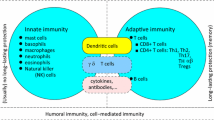Abstract
The evolution of immunology research from measurements of single entities to large-scale data-intensive assays necessitates the integration of experimental work with bioinformatics and computational approaches. The introduction of physics into immunology has led to the study of new phenomena, such as cellular noise, which is likely to prove increasingly important to understand immune system responses. The fusion of “hard science” and biology is also leading to a re-examination of data acquisition, analysis, and statistical validation and is resulting in the development of easy-to-access tools for immunology research. Here, we review some of our models, computational tools, and results related to studies of the innate immune response of human dendritic cells to viral infection. Our project functions on an open model across institutions with electronic record keeping and public sharing of data. Our tools, models, and data can be accessed at http://tsb.mssm.edu/primeportal/.







Similar content being viewed by others
References
Honda K, Sakaguchi S, Nakajima C, Watanabe A, Yanai H, et al. Selective contribution of IFN-α/β signaling to the maturation of dendritic cells induced by double-stranded RNA or viral infection. Proc Nat Acad Sci USA. 2003;100:10872–7.
Park M-S, Shaw ML, Munoz-Jordan J, Cros JF, Nakaya T, et al. Newcastle disease virus (NDV)-based assay demonstrates interferon-antagonist activity for the NDV V protein and the Nipah virus V, W, and C proteins. J Virol. 2003;77:1501–11.
García-Sastre A. Induction and evasion of type I interferon responses by influenza viruses. Virus Res. 2011;162:12–8.
Rao CV, Wolf DM, Arkin AP. Control, exploitation and tolerance of intracellular noise. Nature. 2002;420:231–7.
Eldar A, Elowitz MB. Functional roles for noise in genetic circuits. Nature. 2010;467:167–73.
Ferrell JE, Machleder EM. The biochemical basis of an all-or-none cell fate switch in Xenopus oocytes. Science. 1998;280:895–8.
Hayot F. Simulations of stochastic biological phenomena. Sci Signal. 2011;4:tr13.
Zaslavsky E, Hershberg U, Seto J, Pham A, Marquez S, et al. Antiviral response dictated by choreographed cascade of transcription factors. J Immunol. 2010;184:2908–17.
Gillespie DT. Exact stochastic simulation of coupled chemical-reactions. J Phys Chem. 1977;36(5):2340–61.
Hu J, Sealfon SC, Hayot F, Jayaprakash C, Kumar M, et al. Chromosome-specific and noisy IFNB1 transcription in individual virus-infected human primary dendritic cells. Nucleic Acids Res. 2007;35:5232–41.
Hu J, Iyer-Biswas S, Sealfon SC, Wetmur J, Jayaprakash C, et al. Power-laws in interferon-B mRNA distribution in virus-infected dendritic cells. Biophys J. 2009;97:1984–9.
Apostolou E, Thanos D. Virus infection induces NF-kappaB-dependent interchromosomal associations mediating monoallelic IFN-beta gene expression. Cell. 2008;134:85–96.
Thattai M, van Oudenaarden A. Intrinsic noise in gene regulatory networks. Proc Natl Acad Sci USA. 2001;98:8614–9.
Hu J, Nudelman G, Shimoni Y, Kumar M, Ding Y, et al. Role of cell-to-cell variability in activating a positive feedback antiviral response in human dendritic cells. PLoS ONE. 2011;6:e16614.
Qiao L, Phipps-Yonas H, Hartmann B, Moran TM, Sealfon SC, et al. Immune response modeling of interferon beta-pretreated influenza virus-infected human dendritic cells. Biophys J. 2010;98:505–14.
Seto J, Qiao L, Guenzel CA, Xiao S, Shaw ML, et al. Novel Nipah virus immune-antagonism strategy revealed by experimental and computational study. J Virol. 2010;84:10965–73.
Haller O, Kochs G, Weber F. The interferon response circuit: induction and suppression by pathogenic viruses. Virology. 2006;344:119–30.
Shimoni Y, Fink MY, Choi SG, Sealfon SC. Plato’s cave algorithm: inferring functional signaling networks from early gene expression shadows. PLoS Comput Biol. 2010;6:e1000828.
Bruggeman FJ, Westerhoff HV, Hoek JB, Kholodenko BN. Modular response analysis of cellular regulatory networks. J Theor Biol. 2002;218:507–20.
Sugár IP, Sealfon SC. Misty Mountain clustering: application to fast unsupervised flow cytometry gating. BMC Bioinf. 2010;11:502.
Author information
Authors and Affiliations
Corresponding author
Rights and permissions
About this article
Cite this article
Zaslavsky, E., Hayot, F. & Sealfon, S.C. Computational approaches to understanding dendritic cell responses to influenza virus infection. Immunol Res 54, 160–168 (2012). https://doi.org/10.1007/s12026-012-8322-6
Published:
Issue Date:
DOI: https://doi.org/10.1007/s12026-012-8322-6




